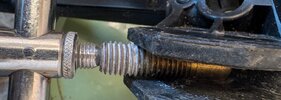Adam Francis
Senior Member & Supporter
I've been using a Daiwa rod pod recently as the Thames has been on red boards for about the last 3 weeks.
The pod is great but unscrewing the legs is somewhat arduous and I wondered if quick release connectors came in larger threads?
I did search online but couldn't find any results but I'm sure someone on here will know
Thanks in advance.
The pod is great but unscrewing the legs is somewhat arduous and I wondered if quick release connectors came in larger threads?
I did search online but couldn't find any results but I'm sure someone on here will know
Thanks in advance.


